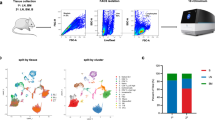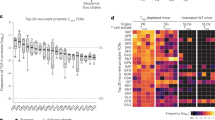Abstract
IT is generally accepted that the diversity of T-cell responsiveness is generated in the thymus1. It is also known that except for a few Lyt 1 cells all thymocytes express the Lyt 123 phenotype2,3. Surprisingly, thymocytes are poorly responsive in vitro4, and only the medullary thymocytes, comprising 5–10% of the total thymic cell population, show an in vitro responsiveness comparable with that of peripheral T cells5. Cortical thymocytes, comprising 90–95% of all thymocytes, have previously been considered to be immature and immunologically incompetent4. The result reported here show that thymocytes are able to generate alloantigen-, virus- and hapten-specific cytotoxic T lymphocytes (CTL), provided a T-cell-derived helper factor is added to the cultures. Furthermore, through the use of cell separation techniques we conclude that in the presence of the helper factor the great majority of Lyt 123+ thymocytes have the capacity to differentiate into either alloreactive or H–2-restricted CTL.
This is a preview of subscription content, access via your institution
Access options
Subscribe to this journal
Receive 51 print issues and online access
$199.00 per year
only $3.90 per issue
Buy this article
- Purchase on Springer Link
- Instant access to full article PDF
Prices may be subject to local taxes which are calculated during checkout
Similar content being viewed by others
References
Jerne, N. K. Eur. J. Immun. 1, 1–9 (1971).
Cantor, H. & Boyse, E. A. J. exp. Med. 141, 1376–1389 (1975).
Matheison, B. J., Sharrow, S. O., Campbell, P. S. & Asofsky, R. Nature 227, 478–480 (1979).
Shortman, K., v. Boehmer, H., Lipp, J. & Hopper, K. Transplantn Rev. 25, 163–210 (1975).
Blomgren, H. & Anderson, B. Expl Cell Res. 57, 185–192 (1969).
Wagner, H., Götze, D., Ptschelinzew, L. & Röllinghoff, M. J. exp. Med. 142, 1477–1487 (1975).
Röllinghoff, M., Starzinski-Powitz, A., Pfizenmaier, K. & Wagner, H. J. exp. Med. 145, 455–459 (1977).
Jung, H., Pfizenmaier, K., Starzinski-Powitz, A., Röllinghoff, M. & Wagner, H. Immunology 34, 763–769 (1978).
London, J., Berrih, S. & Bach, J. F. J. Immun. 121, 438–443 (1978).
Irlé, C., Piguet, P. F. & Vasalli, P. J. exp. Med. 148, 32–45 (1978).
Wagner, H. & Röllinghoff, M. J. exp. Med. 148, 1523–1538 (1978).
Bont, W. S. & De Vries, J. E. in Cell Separation Methods (ed. Bloemendal, H.) 5–13 (Elsevier, Amsterdam, 1977).
Burakoff, S. J., Finberg, R., Glimcher, L., Lemonnier, F., Benacerraf, B. & Cantor, H. J. exp. Med. 148, 1414–1422 (1978).
Cantor, H. & Boyse, E. A. J. exp. Med. 141, 1390–1399 (1975).
Huber, B., Devinsky, O., Gershon, R. K. & Cantor, H. J. exp. Med. 143, 1534–1539 (1976).
Simpson, E. & Beverly, P. C. L. Prog. Immun. 3, 206–216 (1977).
Bevan, M. J. Proc. natn. Acad. Sci. U.S.A. 74, 2094–2098 (1977).
Finberg, R., Burakoff, St. J., Cantor, H. & Benacerraf, B. Proc. natn. Acad. Sci. U.S.A. 75, 5145–5149 (1978).
Jung, H. et al. J. Immun. (in the press).
Author information
Authors and Affiliations
Rights and permissions
About this article
Cite this article
WAGNER, H., RÖLLINGHOFF, M., SCHAWALLER, R. et al. T-cell-derived helper factor allows Lyt 123 thymocytes to differentiate into cytotoxic T lymphocytes. Nature 280, 405–406 (1979). https://doi.org/10.1038/280405a0
Received:
Accepted:
Published:
Issue Date:
DOI: https://doi.org/10.1038/280405a0
This article is cited by
-
Stimulation of interleukin-2 mediated activity of human peripheral blood monuclear cells by lipopolysaccharide and muramyl dipeptide in vitro
Bulletin of Experimental Biology and Medicine (1988)
-
Neue diagnostische Möglichkeiten bei der Funktionsanalyse des zellulären Immunsystems in vitro
Fresenius' Zeitschrift für analytische Chemie (1982)
-
T-cell-derived helper factor allows in vivo induction of cytotoxic T cells in nu/nu mice
Nature (1980)
Comments
By submitting a comment you agree to abide by our Terms and Community Guidelines. If you find something abusive or that does not comply with our terms or guidelines please flag it as inappropriate.



